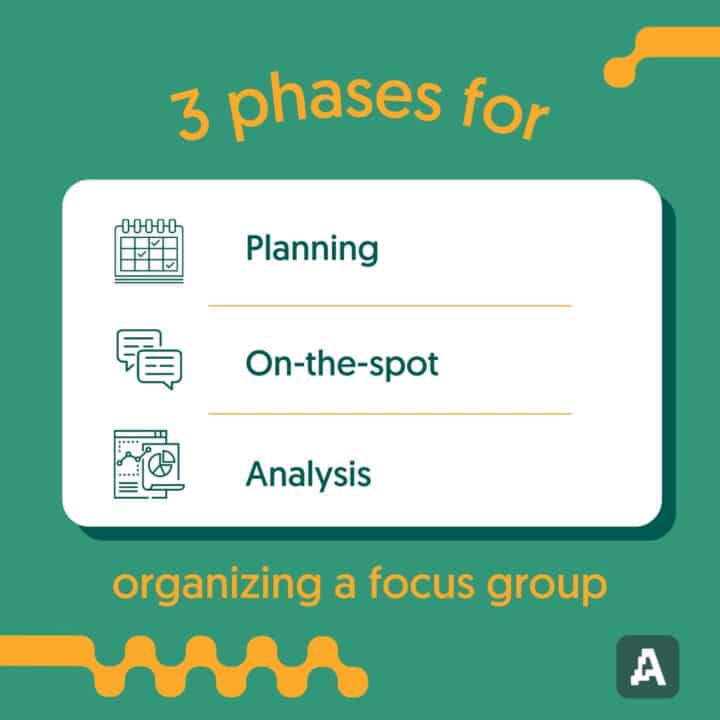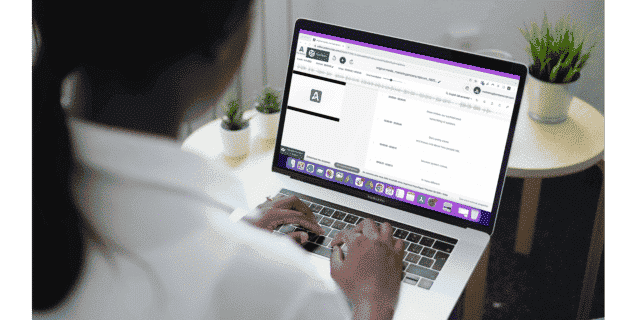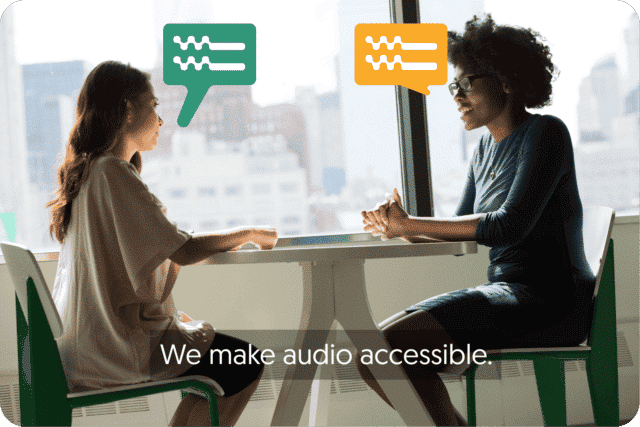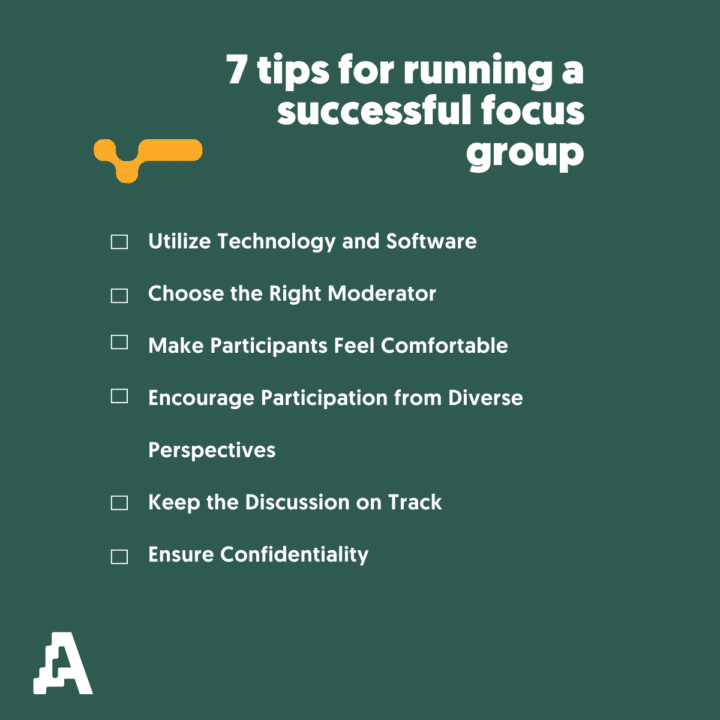Are you conducting social or marketing research? Want to gain more in-depth knowledge of the subject you’re researching? Then it’s very likely that you need to organize a focus group. Read our guide to learn what is a focus group and how to successfully run one!
Table of content
I. What is a focus group?
A focus group is a research method that involves a small group of people discussing a particular topic or product, moderated by a trained facilitator. The purpose of a focus group is to gather qualitative data that provides insight into consumers’ attitudes and opinions, which can help businesses to develop and improve their products or services.
There are 3 phases involved in organizing a focus group: planning, on-the-spot, and analysis.

II. Types of focus groups
There are three main types of focus groups: traditional face-to-face focus groups, online/virtual focus groups, and hybrid focus groups. Traditional focus groups are held in person, while online/virtual focus groups are conducted remotely using video conferencing software, and hybrid focus groups are a combination of both.
Traditional face-to-face focus groups:
They offer the advantage of in-person interaction, which can create a more engaging and immersive experience for participants. However, they can be more expensive to organize, and they require a physical location for the group to meet.
Online/virtual focus groups:
They are more cost-effective and convenient, as they can be conducted remotely, making it easier to reach a wider audience. However, the virtual format can make it more difficult to build rapport and create a sense of community among participants.
Hybrid focus groups:
They combine the benefits of both traditional and online/virtual focus groups. This format allows for in-person interaction, while also leveraging technology to reach a wider audience and reduce costs.
III. Preparing for a focus group
To prepare for a focus group, you need to define your research objectives and questions, determine the number of participants, recruit participants, select a location (if applicable), choose a moderator, and prepare a discussion guide.
1. Pick a single narrow topic
Focus groups have the word “focus” for a reason. In general, you don’t want to go too broad. Choose one specific subject and try to come up with relevant questions. So, instead of asking a lot of different questions about your product/ service – focus on 1 thing. It can be user experience, brand identity, or anything else.
2. Recruit 6-10 participants
How many participants a focus group should have?
We suggest keeping the group size small. The higher number of people goes hand in hand with increased coordination difficulties. The ideal group size is about 6 people.
3. Make sure your group is diverse
You want to make sure that you hear the opinions of different people. You’ll likely want your group members to differ in:
- Age
- National/cultural background
- Income
- Gender
- Interests
Now that you know the scope of your study, it’s time to approach people. You can do it by uploading a post on social media, calling for participation in your focus group. You can also reach out to people individually via email or social media channels.
4. Provide extra incentives for participants
Improving your product/service alone is not that strong of motivation for most consumers. Usually, people would be more inclined to participate in a focus group if they’re offered something in return. It can be a voucher, a gift card, or just some cash.
5. Select a Location
If you’re conducting a traditional face-to-face focus group, you will need to select a location for the group to meet. The location should be convenient for participants to travel to and provide a comfortable environment for the discussion.
6. Choose qualitative research methods – interviews/discussions. Not surveys.
Might sound obvious, but let’s recap it anyway. Focus groups are conducted with a small population sample, but their discussion format allows to obtain detailed information. As such, you should only use qualitative research methods. There is no need to prepare questionnaires or use any methods of statistical analysis.
IV. Conducting the focus group
During the focus group, the moderator will guide the discussion according to the prepared discussion guide. The goal is to elicit open-ended responses and encourage participants to share their opinions and experiences. Here are some tips for conducting a successful focus group:
1. Do an ice-breaking exercise
A lot of people will likely be shy to speak up. That’s why it’s your responsibility to create a welcoming and relaxed atmosphere. You can do so by doing an ice-breaking exercise.
Example: Ask people about their lives. Where have they been traveling on holidays last time? Do they have any pets? What’s their favorite meal?
Alternatively, you can offer free drinks & snacks. We heard that helps!
2. Lead the discussion
When moderating the focus group session, don’t forget that you’re the conversation leader. Here are some things you should take into account:
- Don’t let one person speak for too long, keep it consistent
- Encourage people to share their opinions freely, even if they’re shy
- Keep in mind the structure/question list you’ve made before the focus group. Don’t switch topics too often or too quickly. Nevertheless, you want to change the subject as soon as it’s saturated (no one has anything to add).
3. Ask open questions
Compare these 2 dialogs:
- Example 1: Do you like product X?
- Example 2: Which features of product X are particularly important to you and why?
Open questions (such as the one in Example 2) will help you to obtain richer insights. Avoid asking “yes or no” questions, because the only answer you’ll ever hear is either “yes” or “no”.

Learn more
How to interview and convert audio to text via our interview transcription guide
Learn more4. Different opinions should be encouraged
A Focus group is a discussion. You’re not trying to reach a consensus or find a point that everyone would agree on. On the contrary, you want to observe the contrast in people’s opinions. Even if all of your participants have different viewpoints – don’t make an argument out of it, simply accept it and try to understand what makes them think this way.
5. Approach focus groups with creativity
If you want, you can come up with different ideas on how to engage people, instead of asking them direct questions. For instance, you could:
- Ask participants to draw an image that pops up in their mind when they think about your brand
- Play an associative game. You tell them words – they have to tell you their associations
You can think of any creative tasks that would engage your participants and generate interesting insights for you.
6. Keep the length of the meeting around 1-2 hours
Try not to tire your participants. After an hour or two, we all get tired and are no longer willing to give saturated answers.
7. Record everything
Recording is a “must” for a focus group. You want to be able to come back and review every individual answer. Moreover, you’ll likely have to report your findings. You’ll also be surprised at the number of details you get when you record a discussion, such as tone of voice. To make recording and transcription easier, consider using the Amberscript mobile app (downloadable on iOS and android). With the app, you can record your focus group audio and transcribe it directly, making it easy to review your findings later. Alternatively, you can use the recorder on your phone to capture the audio of the discussion.
P.S. – Don’t forget to inform participants that you’re recording their answers.
P.S.S. – We personally recommend only record audio. Having a video camera may be interrogated for a lot of people and will most likely lead to short, shy (sometimes even dishonest) responses.
If there are details, such as body language that you want to be documented – ask your assistant to take notes on the way.
V. Analyzing the results
Once the focus group is complete, it’s time to analyze the results. This involves transcribing the discussion, reviewing and coding the data, identifying themes and patterns, and drawing conclusions. Here are some tips for analyzing the results:
1. Transcribe your recording with Amberscript
Next, you want your findings to be documented in written form. The easiest way to do it is by using speech recognition software, like Amberscript. Upload your file, make some quick adjustments, and export. Having a transcript simplifies data analysis and makes it easy to share the output with your team.

Get a customized offer
Request a quote for your transcription needs
2. Review and Code the Data
Reviewing and coding the data involves identifying key themes and patterns in the data. This can be done by reviewing the transcripts and identifying recurring ideas or concepts.
3. Identify Themes and Patterns
Identifying themes and patterns involves grouping similar ideas or concepts together to create a coherent picture of the participants’ opinions and attitudes.
4. Draw Conclusions
Drawing conclusions involves synthesizing the data to create actionable insights that can inform business decisions. The conclusions should be based on the data and supported by evidence from the focus group discussion.
VI. Tips for Running a Successful Focus Group

To ensure that your focus group is successful, here are some tips to keep in mind:
Utilize Technology and Software
Technology and software can make the focus group process more efficient and effective. For example, transcription software can save time and reduce the risk of errors, while video conferencing software can make it easier to conduct online/virtual focus groups.
Choose the Right Moderator
The moderator plays a crucial role in guiding the focus group discussion and ensuring that all participants have an opportunity to share their opinions. The moderator should be trained in focus group facilitation and have experience moderating discussions on the topic of interest.
Make Participants Feel Comfortable
Participants are more likely to share their opinions and experiences if they feel comfortable and at ease. The moderator should create a welcoming and inclusive environment that encourages open communication.
Encourage Participation from Diverse Perspectives
Diverse perspectives can provide a more comprehensive understanding of the topic being discussed. The moderator should encourage participation from individuals with different backgrounds, experiences, and opinions.
Keep the Discussion on Track
The moderator should ensure that the discussion stays focused on the research objectives and that all relevant topics are covered. They should also be prepared to redirect the discussion if it veers off track.
Ensure Confidentiality
Participants should feel comfortable sharing their opinions and experiences without fear of their information being shared without their consent. The moderator should ensure that all participants understand the confidentiality policies and procedures in place.
VII. Interview Transcription
Transcription is an essential part of analyzing focus group data, as it converts audio or video recordings of the discussion into a written transcript that can be analyzed and coded. We covered all information you need here at our interview transcription guideline.
There are two main methods of transcription: online and offline.
Online Transcription
Online transcription involves using software or websites to automatically transcribe the audio or video recordings. This method is often faster and more cost-effective than offline transcription, and it can be especially useful for researchers who are working with large amounts of data.
There are a variety of online transcription services available, with varying levels of accuracy and reliability. One such service is Amberscript, which uses advanced algorithms and machine learning to produce accurate and reliable transcripts of focus group discussions. The software also allows users to edit the transcript and add comments or tags to facilitate the analysis process.
Recording and Transcribing Video Calls Online transcription can be particularly useful for focus groups conducted via online platforms such as Zoom, Skype, and Google Meet. To record and transcribe video calls on these platforms, researchers can use software such as OBS Studio, which allows users to record their screen and audio. Once the video call is recorded, the audio can be uploaded to an online transcription service such as Amberscript for automatic transcription.

Offline Transcription
Offline transcription involves manually transcribing the audio or video recordings. This method can be more time-consuming and expensive than online transcription, but it may be necessary in cases where the audio quality is poor or the discussion is particularly complex.
Professional transcriptionists are often hired to transcribe focus group discussions offline. They are trained to accurately transcribe the discussion and may be able to identify nuances in the conversation that an automated transcription service would miss.
Conclusion
In conclusion, focus groups are a valuable tool for market research that provide businesses with valuable insights into their customers’ opinions, attitudes, and preferences. By following the outlined steps and utilizing technology, businesses can ensure a successful focus group and analyze the results accurately. As technology evolves, we can expect even more innovations in focus group research. Keeping up with the latest trends and best practices can help businesses get the most out of their focus group research efforts.
We hope that you are ready for your focus group now!